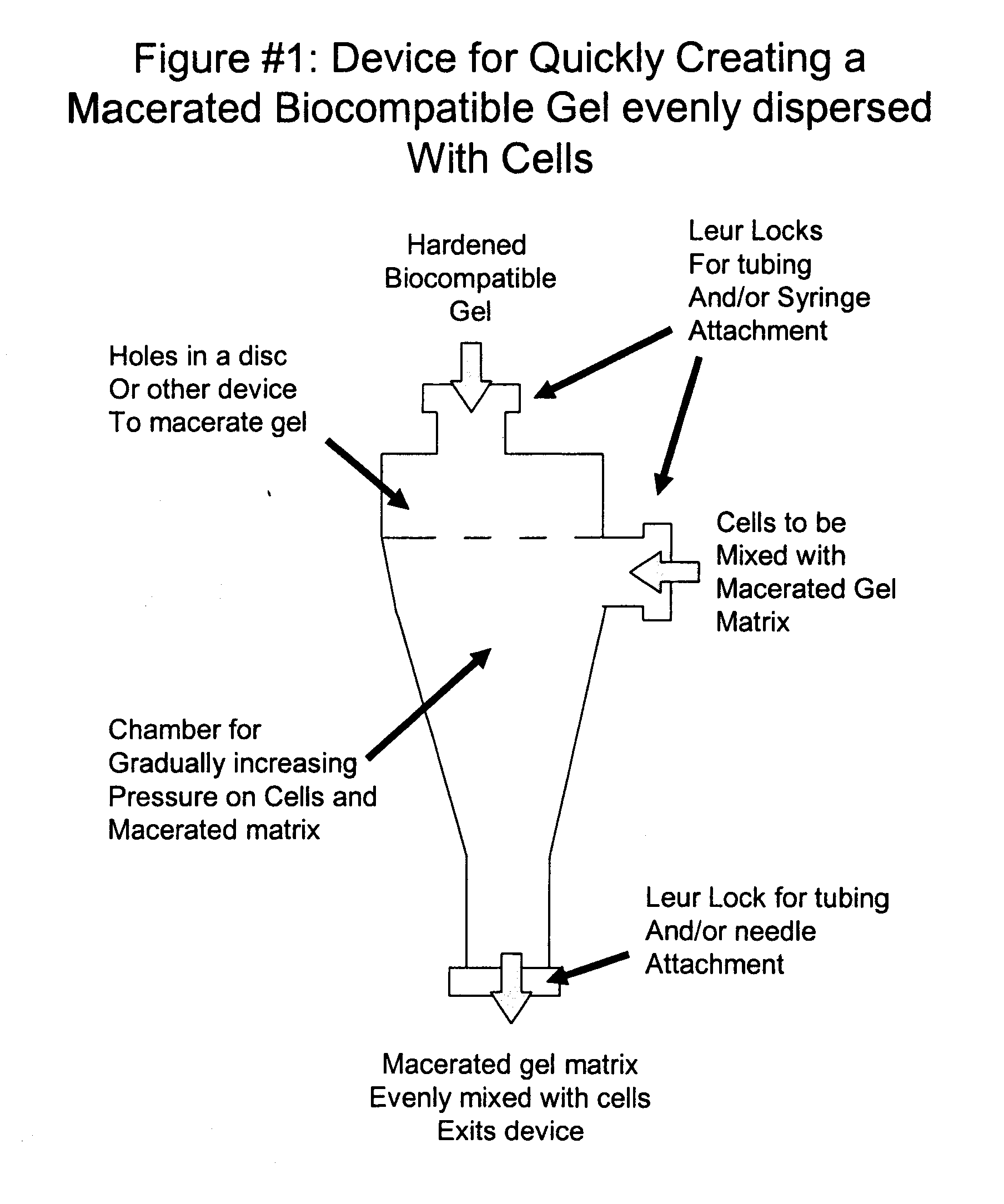Mesenchymal Stem Cell Isolation And Transplantation Method And System To Be Used In A Clinical Setting
a mesenchymal stem cell and clinical setting technology, applied in the field of mesenchymal stem cell transplantation system and method, can solve the problems of unpractical operating room staff's rapid isolating of mesenchymal stem cells, unfavorable regenerative techniques for physicians, and inability to quickly isolate these cells
- Summary
- Abstract
- Description
- Claims
- Application Information
AI Technical Summary
Benefits of technology
Problems solved by technology
Method used
Image
Examples
example 1
Experiment to Determine Which Cells to Negatively Select Out of an Autologous Bone Marrow Sample to Produce the Optimum Combination of MSC's and HPC's to Regenerate Human Intervertebtral Disc or Joints:
[0061]1. A 50 cc bone marrow sample will be obtained from a donor patient[0062]2. The remaining nucleated cell sample will be processed by a fluorescence activated cell sorter (FACS) to isolate the following populations:[0063]a. Cell Sort #1—Control-no processing[0064]b. Cell Sort #2—Remove Glycophorin A only (exclude RBC's only)[0065]c. Cell Sort#3—Remove 90% of Glycophorin A reactive cells[0066]d. Cell Sort #4—Remove CD31, CD14, CD11a, CD45, glycophorin A (exclude RBC's, endothelial cells, monocytes, macrophages, lymphocytes, leukocytes leaving MSC's and CD 34+ heme progenitors)[0067]e. Cell Sort #5—Remove CD31, CD14, CD11a, CD45, glycophorin A, CD 3, CD 14, CD19, CD34, CD 38, CD66b (exclude all non-MSC's)[0068]f. Cell sort #6—Remove CD14, CD11a, CD45, glycophorin A, CD 3, CD 14, C...
example 2
[0075]Experiment to Determine the Appropriate Concentrations and Molecular Weight of Hyaluronic Acid and Fibrinogen and the Degree of the Resultant Gel Maceration Needed to Produce the Greatest Number of Colony Forming Units of Human Mesenchymal Stem Cells In-Vitro and In-Vivo[0076]8. A 50 cc bone marrow sample will be obtained from a donor patient[0077]9. The mix of MSC's and HPC's that provide the best in-vitro result above will be used with isolation techniques already described[0078]10. The remaining nucleated cell sample will be processed by a fluorescence activated cell sorter (FACS) to isolate the population of cells that have been determined by the above experiment to produce the best clinical results.
[0079]Composite mixtures will consist of:[0080]1. HA: (Hyaluronic Acid 0.5 to 3,000 Kda-1-10 mg / ml[0081]2. Fibrinogen: 5-20 mg / mL[0082]11. These will be seeded into four groups of 1 ml each at a density of 100,000 MSC's combined with autologous nucleus pulposis and chondrocytes...
example 3
Various Matrix Combinations Provide Adequate Scaffolding for Proposed MSC Expansion and Differentiation
[0092]Sodium hyaluronate (10 mg / ml) was combined with human fibrinogen (10 mg / ml) at different ratios to test the effect of formulation on the viscosity of potential scaffolds for cell injection. The stock solution of fibrinogen was 55-85 mg / ml, and was therefore diluted 1:7 with normal saline to obtain a concentration of approximately 10 mg / ml. Four formulations were evaluated: 20% HA / 80% fibrinogen, 40% HA / 60% fibrinogen, 60% HA / 40% fibrinogen, and 80% HA / 20% fibrinogen. 20% HA / 80% fibrinogen was the least viscous solution; it was a clear suspension that was easy to pipet. 40% HA / 60% fibrinogen exhibited increased viscosity over the 20% / 80% formulation and was cloudy in appearance. Despite the increased viscosity it was still relatively easy to pipet. 60% HA / 40% fibrinogen was more viscous than the first two formulations, with a cloudy appearance. This solution could be pipetted...
PUM
| Property | Measurement | Unit |
|---|---|---|
| concentration | aaaaa | aaaaa |
| concentration | aaaaa | aaaaa |
| surface | aaaaa | aaaaa |
Abstract
Description
Claims
Application Information
 Login to View More
Login to View More - R&D
- Intellectual Property
- Life Sciences
- Materials
- Tech Scout
- Unparalleled Data Quality
- Higher Quality Content
- 60% Fewer Hallucinations
Browse by: Latest US Patents, China's latest patents, Technical Efficacy Thesaurus, Application Domain, Technology Topic, Popular Technical Reports.
© 2025 PatSnap. All rights reserved.Legal|Privacy policy|Modern Slavery Act Transparency Statement|Sitemap|About US| Contact US: help@patsnap.com

